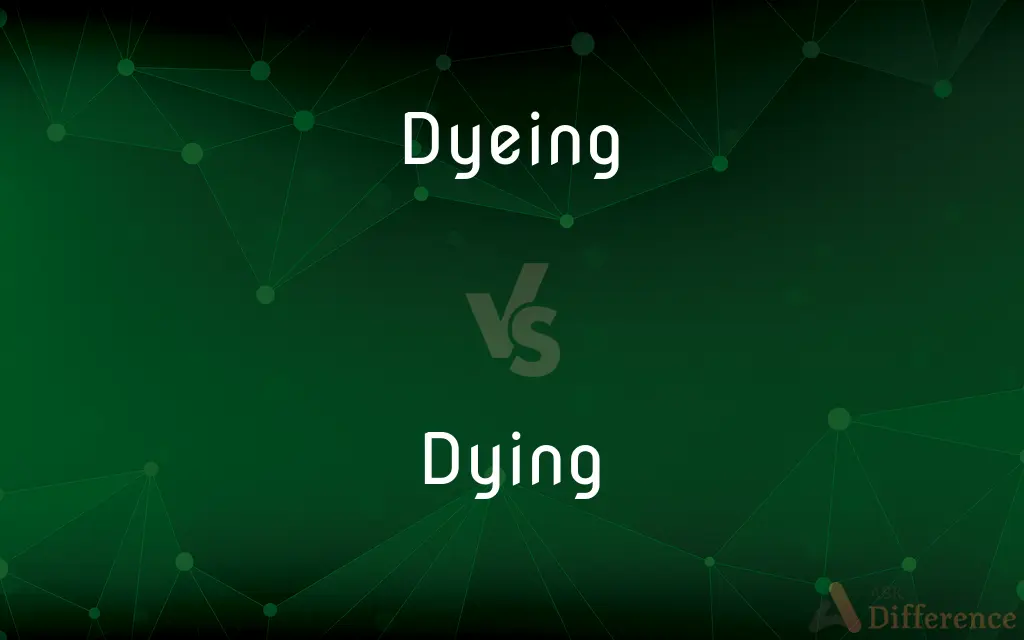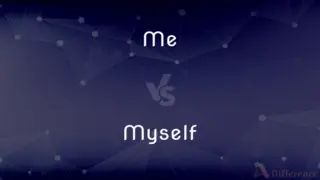Dyeing vs. Dying — What's the Difference?
Edited by Tayyaba Rehman — By Maham Liaqat — Updated on April 1, 2024
Dyeing refers to the process of adding color to materials, while dying pertains to the process of coming to an end or ceasing to live.

Difference Between Dyeing and Dying
Table of Contents
ADVERTISEMENT
Key Differences
Dyeing is the application of color to textiles, hair, or other materials to change their appearance, using dyes that chemically bond to the material. This process can involve natural or synthetic dyes and is used in fashion, manufacturing, and arts and crafts. On the other hand, dying is the act of ceasing to live or exist, applicable to living organisms when their biological functions come to an end. It is a natural part of life's cycle, discussed in medical, ethical, and philosophical contexts.
The techniques involved in dyeing can vary widely, from simple hand-dyeing methods to complex industrial processes designed to ensure color fastness and uniformity across large batches of material. Whereas, the concept of dying does not involve techniques but rather refers to the biological process of organismal cessation, which can be influenced by disease, age, or external factors.
Dyeing is a deliberate, controlled process aimed at achieving a specific aesthetic or functional outcome, such as enhancing the appeal of clothing or crafts. Dying, however, is an inevitable, natural process that all living beings undergo, often discussed in terms of its impact on individuals, families, and societies.
Environmental and health concerns are associated with both terms, but in different contexts. The dyeing industry faces criticism for its environmental impact, including water pollution and toxic chemical use. Dying raises concerns in healthcare, ethics, and environmental impacts related to burial and cremation practices.
Comparison Chart
Definition
The process of applying color to materials.
The process of ceasing to live.
ADVERTISEMENT
Application
Textiles, hair, crafts.
Living organisms.
Techniques
Hand-dyeing, industrial dyeing.
Biological processes influenced by various factors.
Aim
To change or enhance appearance.
An inevitable part of the life cycle.
Environmental Concerns
Water pollution, toxic chemicals.
Burial, cremation, ecological footprint.
Cultural Significance
Associated with creativity and fashion.
Often associated with grief, but varies culturally.
Compare with Definitions
Dyeing
Often seen as an art form or a fashion statement.
The craft of dyeing textiles has been passed down through generations, embodying cultural heritage.
Dying
Cultural attitudes towards dying vary, affecting how it is perceived and managed.
In some cultures, dying is seen as a transition to another existence, marked by specific rites and ceremonies.
Dyeing
Involves various methods from natural dyes to sophisticated chemical processes.
The artisan specialized in dyeing wool using traditional plant-based dyes.
Dying
A natural process influenced by age, disease, and external factors.
Scientists are studying the process of dying in cells to understand aging.
Dyeing
Aimed at enhancing aesthetic appeal or functional value.
Dyeing the curtains a darker shade was meant to block out more sunlight.
Dying
Focuses on palliative care and ethical considerations.
Palliative care aims to provide comfort to those who are dying, addressing physical and emotional needs.
Dyeing
Can impact the environment through chemical runoff.
Textile dyeing factories are working to reduce their environmental footprint by using eco-friendly dyes.
Dying
An inevitable, natural part of life's cycle.
All living things, from the smallest plants to the largest animals, face dying.
Dyeing
Changing the color of materials through the application of dyes.
She spent the afternoon dyeing the fabric blue for her new dress.
Dying
The cessation of all biological functions that sustain a living organism.
The ancient tree was finally dying after standing for centuries.
Dyeing
Dyeing is the application of dyes or pigments on textile materials such as fibers, yarns, and fabrics with the goal of achieving color with desired color fastness. Dyeing is normally done in a special solution containing dyes and particular chemical material.
Dying
Drawing to an end; declining
In the dying hours of the legislative session.
Dyeing
A substance used to color materials. Also called dyestuff.
Dying
(nonstandard) dye
Dyeing
A color imparted by dyeing.
Dying
In or associated with the process of passing from life or ceasing to be;
A dying man
His dying wish
A dying fire
A dying civilization
Dyeing
To color (a material), especially by soaking in a coloring solution.
Dying
Eagerly desirous;
Anxious to see the new show at the museum
Dying to hear who won
Dyeing
To take on or impart color.
Dyeing
Present participle of dye
Dyeing
The act by which something is dyed.
Dyeing
The process or art of fixing coloring matters permanently and uniformly in the fibers of wool, cotton, etc.
Dyeing
The use of dye to change the color of something permanently
Common Curiosities
What does dyeing involve?
Dyeing involves applying dyes to materials like textiles or hair to change their color, using various techniques for different effects.
Can dyeing have negative environmental impacts?
Yes, dyeing can contribute to environmental pollution through water waste and the use of toxic chemicals.
Is dying always related to illness?
Not necessarily; dying can result from a natural end of life, illness, accidents, or other factors.
What does dying mean?
Dying refers to the end of life in living organisms, when biological functions cease.
How are dyeing and dying different?
Dyeing is a creative process aimed at adding color to materials, while dying is a natural biological process marking the end of life.
What is palliative care?
Palliative care is medical care aimed at relieving the symptoms and stress of serious illness, often in the context of dying.
How does the fashion industry address environmental concerns related to dyeing?
The fashion industry is exploring sustainable dyeing technologies and practices to reduce water and chemical use.
Can the process of dyeing be done at home?
Yes, many dyeing techniques can be done at home with the right materials and safety precautions.
Are there eco-friendly dyeing methods?
Yes, there are eco-friendly dyeing methods that use natural dyes and minimize water and chemical use.
How do cultures view dying?
Cultural views on dying vary widely, with some seeing it as a passage to another life or existence, while others focus on legacy and memory.
What ethical issues arise in end-of-life care?
Ethical issues include decisions about life support, euthanasia, and the right to die with dignity.
How can individuals prepare for the end of life?
Preparation can include making a will, discussing wishes with loved ones, and considering palliative care options.
What are some common symbols associated with dying?
Symbols of dying include the skull, the color black in many cultures, and natural imagery like falling leaves.
What role does genetics play in dying?
Genetics can influence susceptibility to certain diseases and conditions that may affect lifespan and the dying process.
Is there a way to dye materials without chemicals?
Yes, natural dyeing uses substances like plants, minerals, and insects to color materials without synthetic chemicals.
Share Your Discovery

Previous Comparison
Me vs. Myself
Next Comparison
Cataloguing vs. CatalogueAuthor Spotlight
Written by
Maham LiaqatEdited by
Tayyaba RehmanTayyaba Rehman is a distinguished writer, currently serving as a primary contributor to askdifference.com. As a researcher in semantics and etymology, Tayyaba's passion for the complexity of languages and their distinctions has found a perfect home on the platform. Tayyaba delves into the intricacies of language, distinguishing between commonly confused words and phrases, thereby providing clarity for readers worldwide.















































